RAD@home Citizen Science Discovery of Two Spiral Galaxies Where the 30–220 kpc Radio Lobes Are Possibly Shaped by Ram Pressure Stripping
Abstract
1. Introduction
2. RAD@home Citizen Science Discovery Method
3. Results
3.1. Radio Lobes of NGC3898 or a Background Radio Galaxy?
3.2. RAD-Thumbs up Galaxy: Speca or Radio Phoenix?
4. Discussion
4.1. NGC3898: Not Bending but Stripping
4.2. RAD-Thumbs up Galaxy: Bent, Episodic, and Stripped
4.3. Unique Context
Author Contributions
Funding
Institutional Review Board Statement
Informed Consent Statement
Data Availability Statement
Acknowledgments
Conflicts of Interest
References
- Hota, A.; Sirothia, S.K.; Ohyama, Y.; Konar, C.; Kim, S.; Rey, S.C.; Saikia, D.J.; Croston, J.H.; Matsushita, S. Discovery of a spiral-host episodic radio galaxy. Mon. Not. R. Astron. Soc. 2011, 417, L36–L40. [Google Scholar] [CrossRef]
- Bagchi, J.; Vivek, M.; Vikram, V.; Hota, A.; Biju, K.G.; Sirothia, S.K.; Srianand, R.; Gopal-Krishna; Jacob, J. Megaparsec relativistic jets launched from an accreting supermassive black hole in an extreme spiral galaxy. Astrophys. J. 2014, 788, 174–191. [Google Scholar] [CrossRef]
- Sethi, S.; Kuźmicz, A.; Hunik, D.; Jamrozy, M. Serendipitous discovery of a spiral host in a 2 Mpc double-double lobed radio galaxy. Astron. Astrophys. 2025, in press. [CrossRef]
- Baum, S.A.; O’Dea, C.P.; Dallacassa, D.; de Bruyn, A.G.; Pedlar, A. Kiloparsec-Scale Radio Emission in Seyfert Galaxies: Evidence for Starburst-driven Superwinds? Astrophys. J. 1993, 419, 553–572. [Google Scholar] [CrossRef]
- Colbert, E.J.M.; Baum, S.A.; Gallimore, J.F.; O’Dea, C.P.; Christensen, J.A. Large-Scale Outflows in Edge-on Seyfert Galaxies. II. Kiloparsec-Scale Radio Continuum Emission. Astrophys. J. 1996, 467, 551–578. [Google Scholar] [CrossRef]
- Gallimore, J.F.; Axon, D.J.; O’Dea, C.P.; Baum, S.A.; Pedlar, A. A Survey of Kiloparsec-Scale Radio Outflows in Radio-Quiet Active Galactic Nuclei. Astron. J. 2006, 132, 546–569. [Google Scholar] [CrossRef]
- Hota, A.; Saikia, D.J. Radio bubbles in the composite AGN-starburst galaxy NGC 6764. Mon. Not. R. Astron. Soc. 2006, 371, 945–956. [Google Scholar] [CrossRef]
- Webster, B.; Croston, J.H.; Mingo, B.; Baldi, R.D.; Barkus, B.; Gürkan, G.; Hardcastle, M.J.; Morganti, R.; Röttgering, H.J.A.; Sabater, J.; et al. A population of galaxy-scale jets discovered using LOFAR. Mon. Not. R. Astron. Soc. 2021, 500, 4921–4936. [Google Scholar] [CrossRef]
- Cecil, G.; Greenhill, L.J.; DePree, C.G.; Nagar, N.; Wilson, A.S.; Dopita, M.A.; Pérez-Fournon, I.; Argon, A.L.; Moran, J.M. The Active Jet in NGC 4258 and Its Associated Shocks. Astrophys. J. 2000, 536, 675–696. [Google Scholar] [CrossRef]
- Capetti, A.; Axon, D.J.; Macchetto, F.D.; Marconi, A.; Winge, C. The Origin of the Narrow-Line Region of Markarian 3: An Overpressured Jet Cocoon. Astrophys. J. 1999, 516, 187194. [Google Scholar] [CrossRef][Green Version]
- Verdoes Kleijn, G.A.; de Zeeuw, P.T. A dichotomy in the orientation of dust and radio jets in nearby low-power radio galaxies. Astron. Astrophys. 2005, 435, 43–64. [Google Scholar] [CrossRef]
- Kinney, A.L.; Schmitt, H.R.; Clarke, C.J.; Pringle, J.E.; Ulvestad, J.S.; Antonucci, R.R.J. Jet Directions in Seyfert Galaxies. Astrophys. J. 2000, 537, 152–177. [Google Scholar] [CrossRef]
- Gunn, J.E.; Gott, J.R., III. On the Infall of Matter Into Clusters of Galaxies and Some Effects on Their Evolution. APJ 1972, 176, 1. [Google Scholar] [CrossRef]
- Abadi, M.G.; Moore, B.; Bower, R.G. Ram pressure stripping of spiral galaxies in clusters. Mon. Not. R. Astron. Soc. 1999, 308, 947–954. [Google Scholar] [CrossRef]
- Ignesti, A.; Vulcani, B.; Poggianti, B.M.; Moretti, A.; Shimwell, T.; Botteon, A.; van Weeren, R.J.; Roberts, I.D.; Fritz, J.; Tomičić, N.; et al. Walk on the Low Side: LOFAR Explores the Low-frequency Radio Emission of GASP Jellyfish Galaxies. Astrophys. J. 2022, 937, 58. [Google Scholar] [CrossRef]
- Croton, D.J.; Springel, V.; White, S.D.; De Lucia, G.; Frenk, C.S.; Gao, L.; Jenkins, A.; Kauffmann, G.; Navarro, J.F.; Yoshida, N. The many lives of active galactic nuclei: Cooling flows, black holes and the luminosities and colours of galaxies. Mon. Not. R. Astron. Soc. 2006, 365, 11–28. [Google Scholar] [CrossRef]
- Hardcastle, M.J.; Croston, J.H. Radio galaxies and feedback from AGN jets. New Astron. Rev. 2020, 88, 101539. [Google Scholar] [CrossRef]
- Hota, A.; Konar, C.; Stalin, C.S.; Vaddi, S.; Mohanty, P.K.; Dabhade, P.; Dharmik Bhoga, S.A.; Rajoria, M.; Sethi, S. Tracking Galaxy Evolution Through Low-Frequency Radio Continuum Observations using SKA and Citizen-Science Research using Multi-Wavelength Data. J. Astrophys. Astron. 2016, 37, 41. [Google Scholar] [CrossRef][Green Version]
- Hota, A.; Dabhade, P.; Vaddi, S.; Konar, C.; Pal, S.; Gulati, M.; Stalin, C.S.; Avinash, C.K.; Kumar, A.; Rajoria, M.; et al. RAD@home citizen science discovery of an active galactic nucleus spewing a large unipolar radio bubble on to its merging companion galaxy. Mon. Not. R. Astron. Soc. 2022, 517, L86–L91. [Google Scholar] [CrossRef]
- Wright, E.L.; Eisenhardt, P.R.; Mainzer, A.K.; Ressler, M.E.; Cutri, R.M.; Jarrett, T.; Kirkpatrick, J.D.; Padgett, D.; McMillan, R.S.; Skrutskie, M.; et al. The Wide-field Infrared Survey Explorer (WISE): Mission Description and Initial On-orbit Performance. Astron. J. 2010, 140, 1868–1881. [Google Scholar] [CrossRef]
- Morrissey, P.; Conrow, T.; Barlow, T.A.; Small, T.; Seibert, M.; Wyder, T.K.; Budavári, T.; Arnouts, S.; Friedman, P.G.; Forster, K.; et al. The Calibration and Data Products of GALEX. Astrophys. J. Suppl. Ser. 2007, 173, 682. [Google Scholar] [CrossRef]
- Kumar, A.; Avinash, C.K.; Purohit, A.; Hota, A. RAD@home RGB-maker web-tool for citizen science research in multi-wavelength study of AGNs with radio jets. Proc. Int. Astron. Union 2021, 17 (Suppl. S375), 40–41. [Google Scholar] [CrossRef]
- Intema, H.T.; Jagannathan, P.; Mooley, K.P.; Frail, D.A. The GMRT 150 MHz all-sky radio survey. First alternative data release TGSS ADR1. Astron. Astrophys. 2017, 598, A78. [Google Scholar] [CrossRef]
- Condon, J.J.; Cotton, W.D.; Greisen, E.W.; Yin, Q.F.; Perley, R.A.; Taylor, G.B.; Broderick, J.J. The NRAO VLA Sky Survey. Astron. J. 1998, 115, 1693–1716. [Google Scholar] [CrossRef]
- Becker, R.H.; White, R.L.; Helfand, D.J. The FIRST Survey: Faint Images of the Radio Sky at Twenty Centimeters. Astron. J. 1995, 450, 559. [Google Scholar] [CrossRef]
- de Gasperin, F.; Intema, H.T.; Frail, D.A. A radio spectral index map and catalogue at 147–1400 MHz covering 80 per cent of the sky. Mon. Not. R. Astron. Soc. 2018, 474, 5008–5022. [Google Scholar] [CrossRef]
- Trentham, N.; Tully, R.B.; Verheijen, M.A. The Ursa Major cluster of galaxies—III. Optical observations of dwarf galaxies and the luminosity function down to MR=-11. Mon. Not. R. Astron. Soc. 2001, 325, 385–404. [Google Scholar] [CrossRef]
- Tempel, E.; Tuvikene, T.; Kipper, R.; Libeskind, N.I. Merging groups and clusters of galaxies from the SDSS data-The catalogue of groups and potentially merging systems. Astron. Astrophys. 2017, 602, A100. [Google Scholar] [CrossRef]
- Shimwell, T.W.; Hardcastle, M.J.; Tasse, C.; Best, P.N.; Röttgering, H.J.A.; Williams, W.L.; Botteon, A.; Drabent, A.; Mechev, A.; Shulevski, A.; et al. The LOFAR Two-metre Sky Survey. V. Second data release. Astron. Astrophys. 2022, 659, 27. [Google Scholar] [CrossRef]
- Zou, H.; Zhou, X.; Fan, X.; Zhang, T.; Zhou, Z.; Nie, J.; Peng, X.; McGreer, I.; Jiang, L.; Dey, A.; et al. Project Overview of the Beijing-Arizona Sky Survey. Publ. Astron. Soc. Pac. 2017, 129, 064101. [Google Scholar] [CrossRef]
- Shimwell, T.W.; Tasse, C.; Hardcastle, M.J.; Mechev, A.P.; Williams, W.L.; Best, P.N.; Röttgering, H.J.A.; Callingham, J.R.; Dijkema, T.J.; De Gasperin, F.; et al. The LOFAR Two-metre Sky Survey. II. First data release. Astron. Astrophys. 2019, 622, A1. [Google Scholar] [CrossRef]
- Dabhade, P.; Saikia, D.J.; Mahato, M. Decoding the giant extragalactic radio sources. J. Astrophys. Astron. 2023, 44, 13. [Google Scholar] [CrossRef]
- Thilker, D.A.; Bianchi, L.; Meurer, G.; De Paz, A.G.; Boissier, S.; Madore, B.F.; Boselli, A.; Ferguson, A.M.; Muńoz-Mateos, J.C.; Madsen, G.J.; et al. A Search for Extended Ultraviolet Disk (XUV-Disk) Galaxies in the Local Universe. Astrophys. J. Suppl. Ser. 2007, 173, 538. [Google Scholar] [CrossRef]
- Bonnarel, F.; Fernique, P.; Bienaymé, O.; Egret, D.; Genova, F.; Louys, M.; Ochsenbein, F.; Wenger, M.; Bartlett, J.G. The ALADIN interactive sky atlas. A reference tool for identification of astronomical sources. Astron. Astrophys. Suppl. 2000, 143, 33–40. [Google Scholar] [CrossRef]
- Vega Beltrán, J.C.; Pizzella, A.; Corsini, E.M.; Funes, J.G.; Zeilinger, W.W.; Beckman, J.E.; Bertola, F. Kinematic properties of gas and stars in 20 disc galaxies. Astron. Astrophys. 2001, 374, 394–411. [Google Scholar] [CrossRef]
- Pignatelli, E.; Corsini, E.M.; Vega Beltrán, J.C.; Scarlata, C.; Pizzella, A.; Funes, S.J.J.G.; Zeilinger, W.W.; Beckman, J.E.; Bertola, F. Modelling gaseous and stellar kinematics in the disc galaxies NGC 772, 3898 and 7782. Mon. Not. R. Astron. Soc. 2001, 323, 188–210. [Google Scholar] [CrossRef]
- McConnell, D.; Hale, C.L.; Lenc, E.; Banfield, J.K.; Heald, G.; Hotan, A.W.; Leung, J.K.; Moss, V.A.; Murphy, T.; O’Brien, A.; et al. The Rapid ASKAP Continuum Survey I: Design and first results. Publ. Astron. Soc. Aust. 2020, 37, 48. [Google Scholar] [CrossRef]
- Duchesne, S.W.; Thomson, A.J.M.; Pritchard, J.; Lenc, E.; Moss, V.A.; McConnell, D.; Wieringa, M.H.; Whiting, M.T.; Wang, Z.; Wang, Y.; et al. The Rapid ASKAP Continuum Survey IV: Continuum imaging at 1367.5 MHz and the first data release of RACS-mid. Publ. Astron. Soc. Aust. 2023, 40, e034. [Google Scholar] [CrossRef]
- Hopkins, A.M.; Kapinska, A.; Marvil, J.; Vernstrom, T.; Collier, J.D.; Norris, R.P.; Gordon, Y.A.; Duchesne, S.W.; Rudnick, L.; Gupta, N.; et al. The Evolutionary Map of the Universe: A new radio atlas for the southern hemisphere sky. Publ. Astron. Soc. Aust. 2025, 42, e071. [Google Scholar] [CrossRef]
- Dey, A.; Schlegel, D.J.; Lang, D.; Blum, R.; Burleigh, K.; Fan, X.; Findlay, J.R.; Finkbeiner, D.; Herrera, D.; Juneau, S.; et al. Overview of the DESI Legacy Imaging Surveys. Astron. J. 2019, 157, 168. [Google Scholar] [CrossRef]
- Wen, Z.L.; Han, J.L. Calibration of the Optical Mass Proxy for Clusters of Galaxies and an Update of the WHL12 Cluster Catalog. Astrophys. J. 2015, 807, 178. [Google Scholar] [CrossRef]
- Sankhyayan, S.; Bagchi, J.; Tempel, E.; More, S.; Einasto, M.; Dabhade, P.; Raychaudhury, S.; Athreya, R.; Heinämäki, P. Identification of Superclusters and Their Properties in the Sloan Digital Sky Survey Using the WHL Cluster Catalog. Astrophys. J. 2023, 958, 62. [Google Scholar] [CrossRef]
- Van Weeren, R.J.; De Gasperin, F.; Akamatsu, H.; Brüggen, M.; Feretti, L.; Kang, H.; Stroe, A.; Zandanel, F. Diffuse Radio Emission from Galaxy Clusters. Space Sci. Rev. 2019, 215, 16. [Google Scholar] [CrossRef]
- Enßlin, T.A.; Gopal-Krishna. Reviving fossil radio plasma in clusters of galaxies by adiabatic compression in environmental shock waves. Astron. Astrophys. 2001, 366, 26–34. [Google Scholar] [CrossRef]
- Mandal, S.; Intema, H.T.; van Weeren, R.J.; Shimwell, T.W.; Botteon, A.; Brunetti, G.; de Gasperin, F.; Brüggen, M.; Di Gennaro, G.; Kraft, R.; et al. Revived fossil plasma sources in galaxy clusters. Astron. Astrophys. 2020, 634, A4. [Google Scholar] [CrossRef]
- Riseley, C.J.; Vernstrom, T.; Lovisari, L.; O’Sullivan, E.; Gastaldello, F.; Brienza, M.; Nayak, P.K.; Bonafede, A.; Carretti, E.; Duchesne, S.W.; et al. Relighting the fire in Hickson Compact Group (HCG) 15: Magnetised fossil plasma revealed by the SKA Pathfinders and Precursors. Astron. Astrophys. 2025, 697, A45. [Google Scholar] [CrossRef]
- Boissier, S.; Boselli, A.; Duc, P.A.; Cortese, L.; Van Driel, W.; Heinis, S.; Voyer, E.; Cucciati, O.; Ferrarese, L.; Côté, P.; et al. The GALEX Ultraviolet Virgo Cluster Survey (GUViCS). II. Constraints on star formation in ram-pressure stripped gas. Astron. Astrophys. 2012, 545, A142. [Google Scholar] [CrossRef]
- Hota, A.; Saikia, D.J.; Irwin, J.A. NGC 4438 and its environment at radio wavelengths. Mon. Not. R. Astron. Soc. 2007, 380, 1009–1022. [Google Scholar] [CrossRef]
- Gao, X.Y.; Yuan, Z.S.; Han, J.L.; Wen, Z.L.; Shan, S.S. Three New Spiral Galaxies with Active Nuclei Producing Double Radio Lobes. Res. Astron. Astrophys. 2023, 23, 035005. [Google Scholar] [CrossRef]
- Yuan, Z.S.; Gao, X.Y.; Wen, Z.L.; Han, J.L. Four Late-type Galaxies with Double Radio Lobes and Properties of Such Galaxies. Res. Astron. Astrophys. 2024, 24, 045007. [Google Scholar] [CrossRef]
- O’Dea, C.P.; Daly, R.A.; Kharb, P.; Freeman, K.A.; Baum, S.A. Physical properties of very powerful FRII radio galaxies. Astron. Astrophys. 2009, 494, 471–488. [Google Scholar] [CrossRef]
- Gopal-Krishna; Wiita, P.J. Asymmetries in Powerful Extragalactic Radio Sources. Asian J. Phys. 2004. [Google Scholar] [CrossRef]
- Gopal-Krishna; Wiita, P.J. On the Origin of Correlated Radio-optical Asymmetries in Double Radio Sources. Astrophys. J. 1996, 467, 191. [Google Scholar] [CrossRef]
- Freeland, E.; Wilcots, E. Intergalactic Gas in Groups of Galaxies: Implications for Dwarf Spheroidal Formation and the Missing Baryons Problem. Astrophys. J. 2011, 738, 145. [Google Scholar] [CrossRef]
- Kantharia, N.G.; Ananthakrishnan, S.; Nityananda, R.; Hota, A. GMRT observations of the group Holmberg 124: Evolution by tidal forces and ram pressure? Astron. Astrophys. 2005, 435, 483–496. [Google Scholar] [CrossRef][Green Version]
- Saikia, D.J.; Jamrozy, M. Recurrent activity in Active Galactic Nuclei. Bull. Astron. Soc. India 2009, 37, 63–89. [Google Scholar][Green Version]
- Dabhade, P.; Chavan, K.; Saikia, D.J.; Oei, M.S.; Röttgering, H.J. Search and analysis of giant radio galaxies with associated nuclei (SAGAN)-V. Study of giant double-double radio galaxies from LoTSS DR2. Astron. Astrophys. 2025, 696, A97. [Google Scholar] [CrossRef]
- Hummel, E.; Saikia, D.J. The anomalous radio features in NGC 4388 and NGC 4438. Astron. Astrophys. 1991, 249, 43–56. [Google Scholar]
- Chyzy, K.T.; Soida, M.; Bomans, D.J.; Balkowski, C.; Beck, R.; Urbanik, M. Large-scale magnetized outflows from the Virgo Cluster spiral NGC4569. Astron. Astrophys. 2006, 447, 447–465. [Google Scholar] [CrossRef][Green Version]
- Mukherjee, D.; Bicknell, G.V.; Wagner, A.Y.; Sutherl, R.S.; Silk, J. Relativistic jet feedback—III. Feedback on gas discs. Mon. Not. R. Astron. Soc. 2018, 479, 5544–5566. [Google Scholar] [CrossRef]
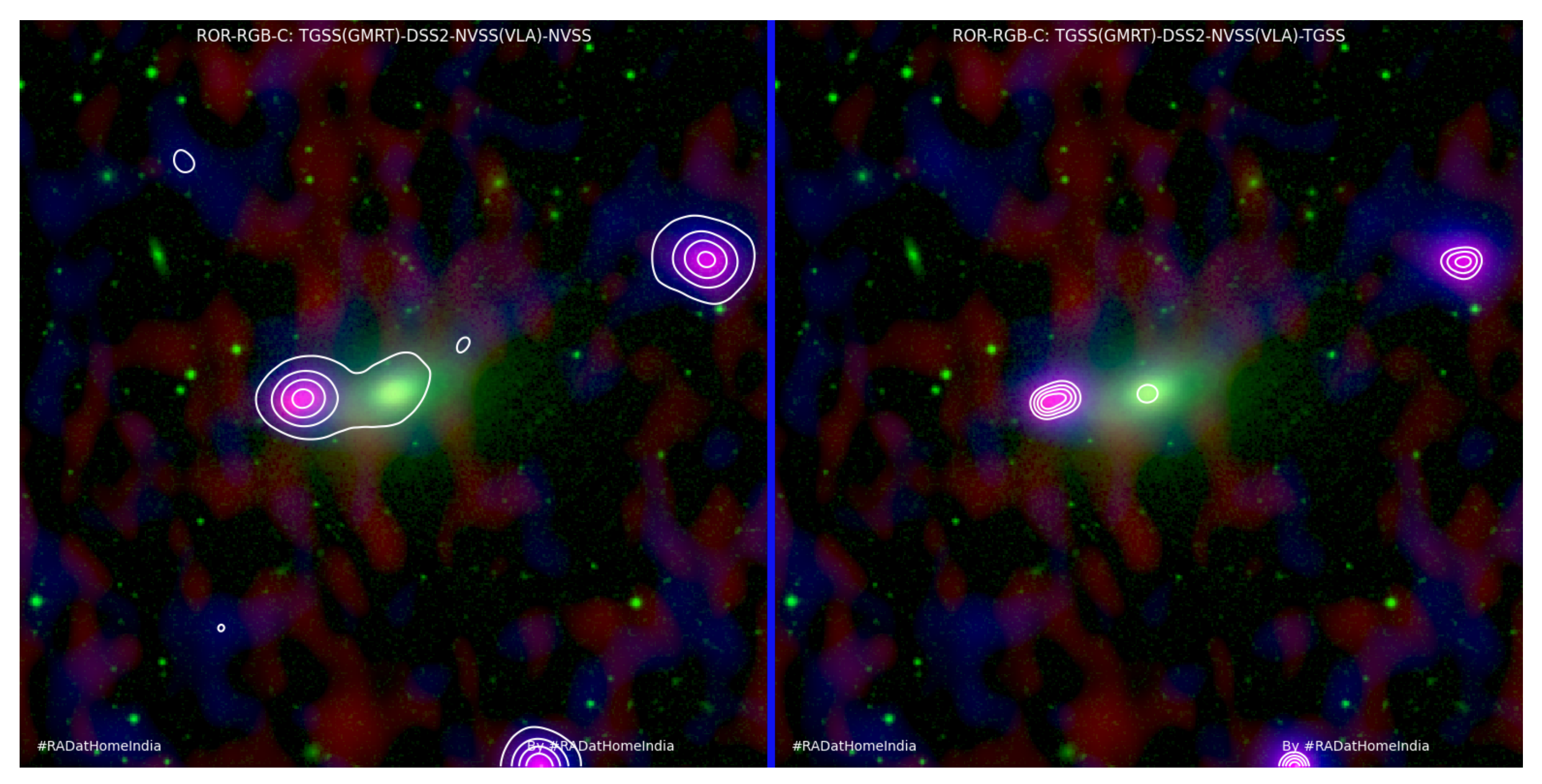
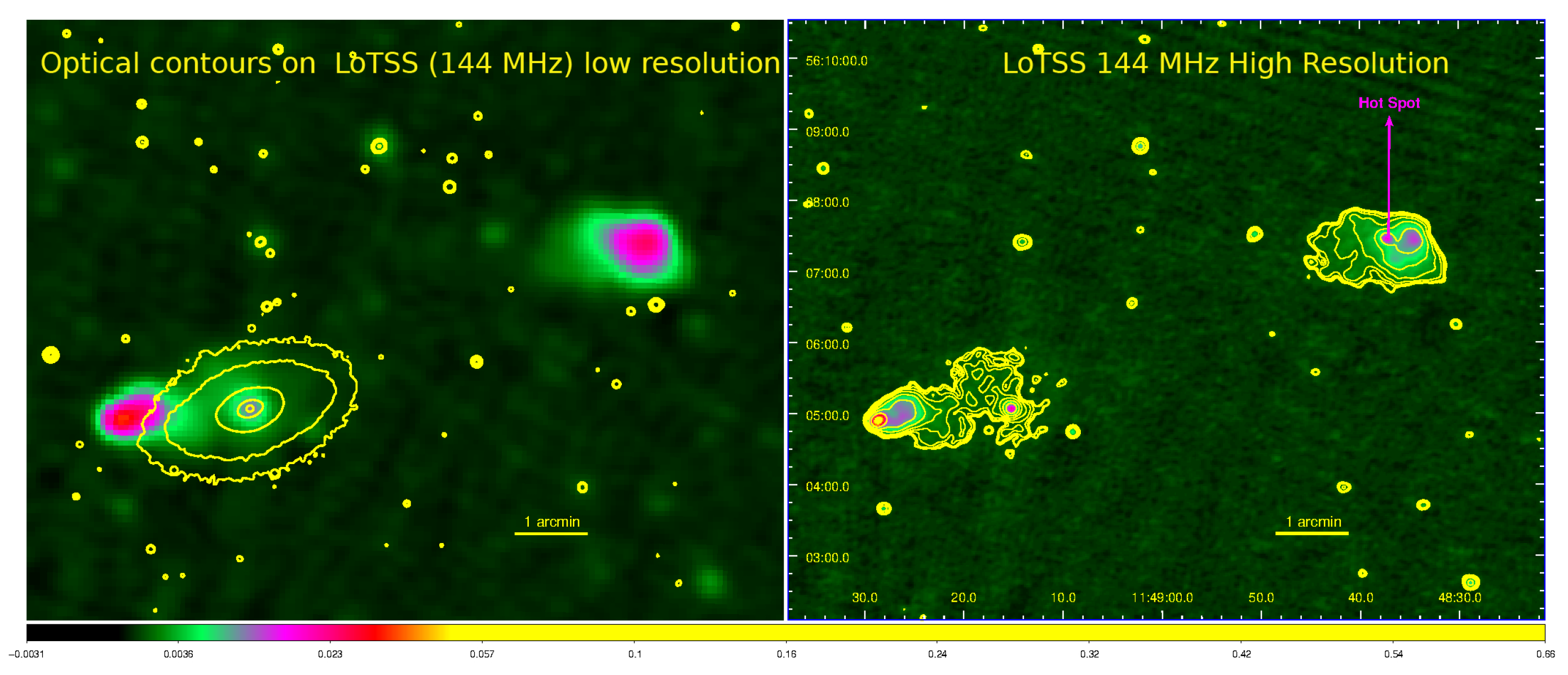
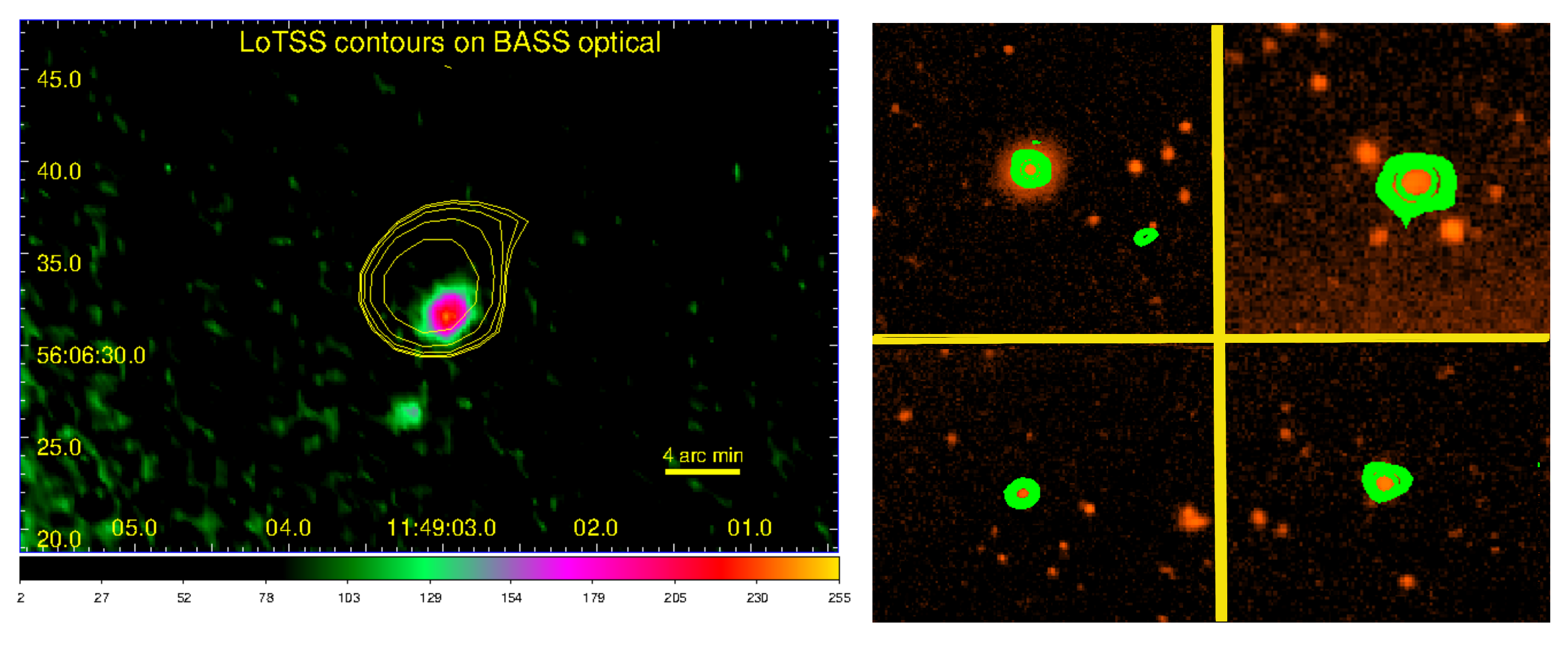
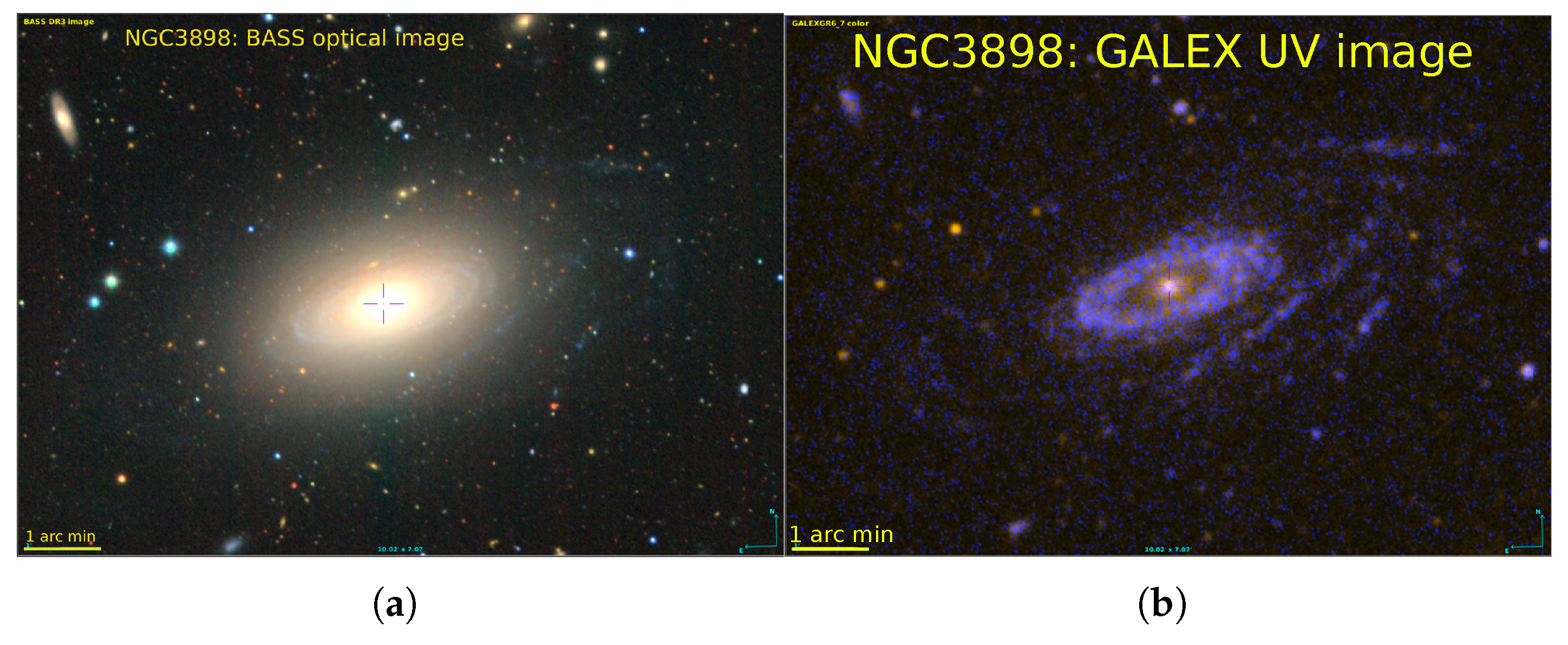

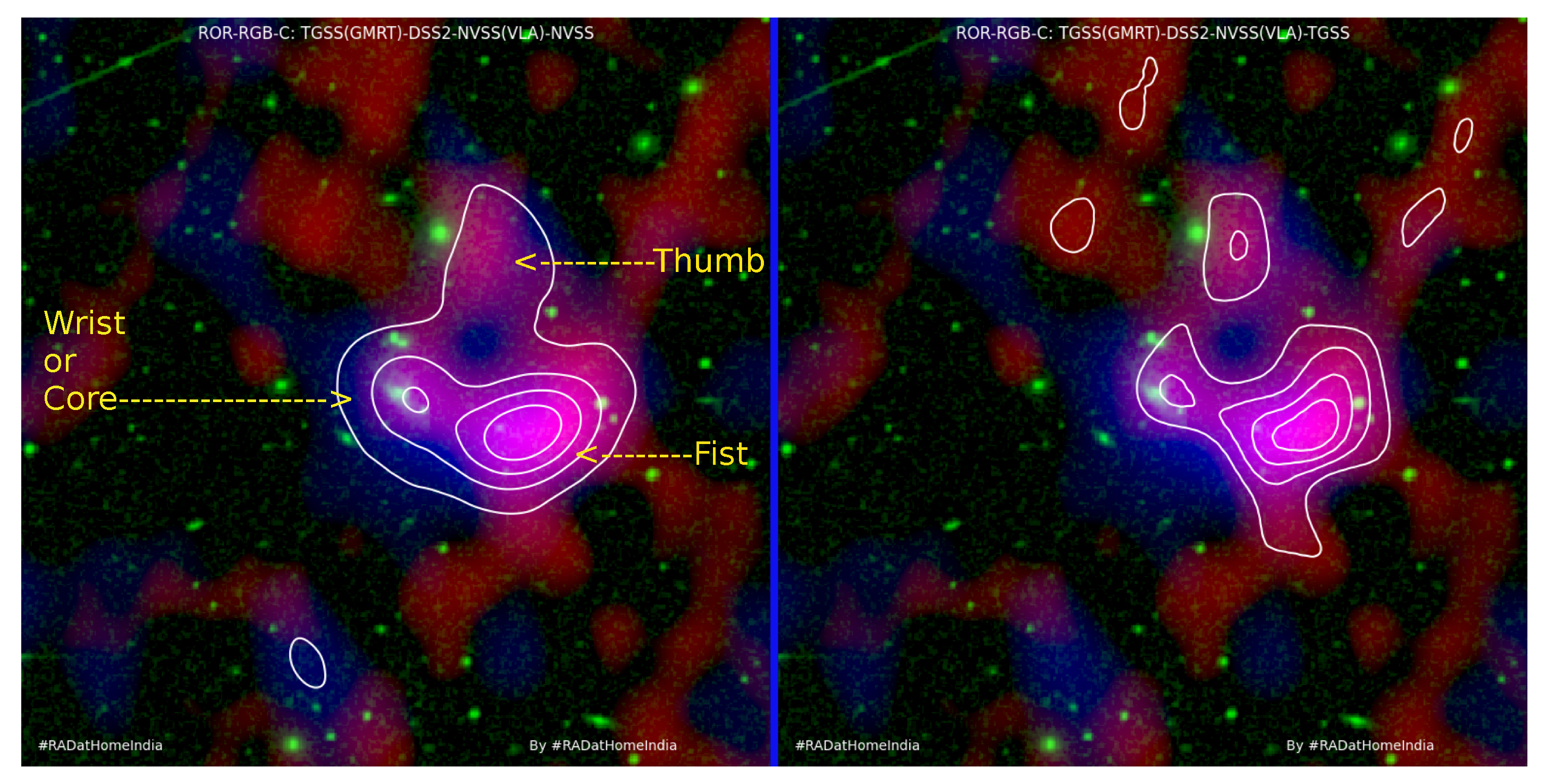
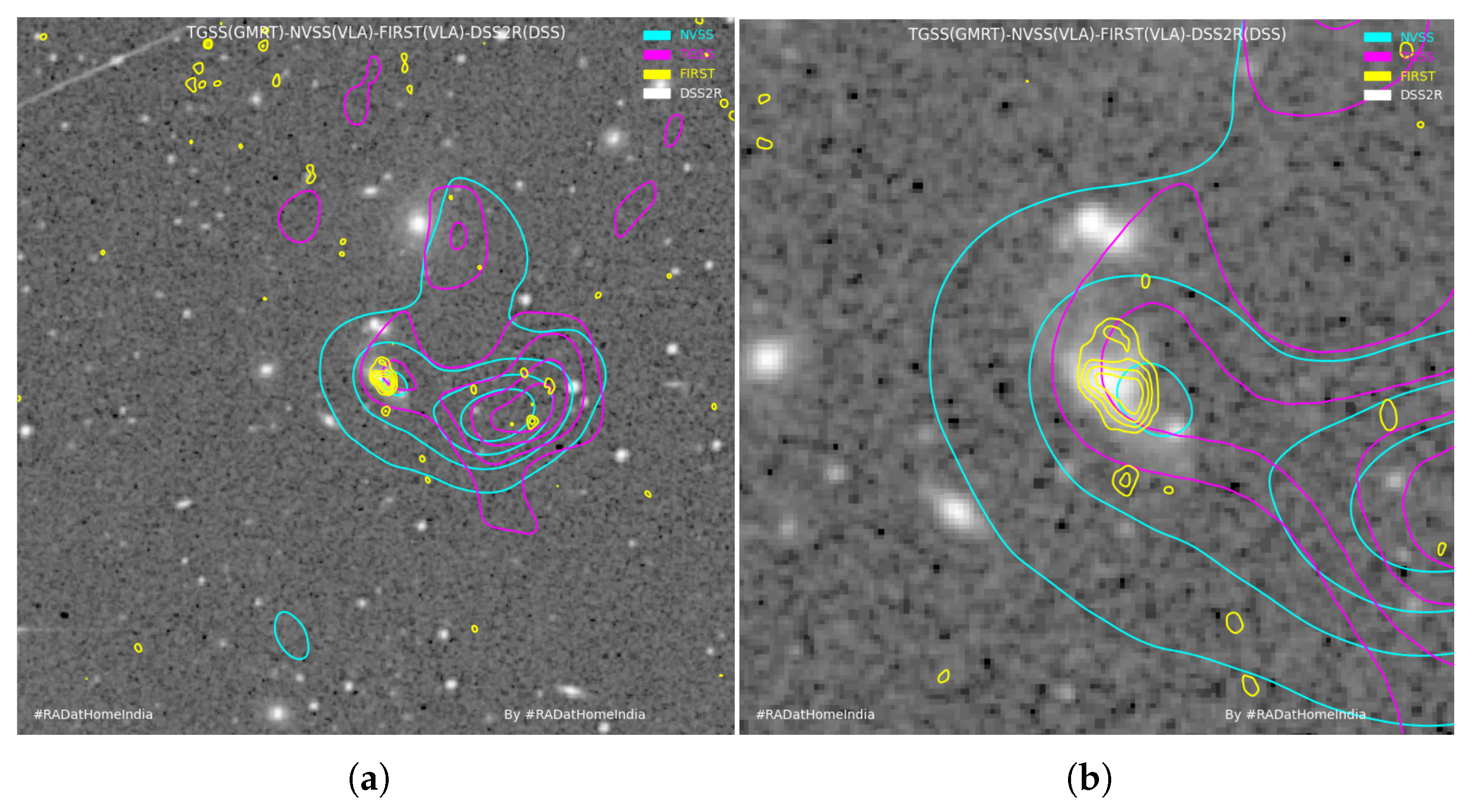

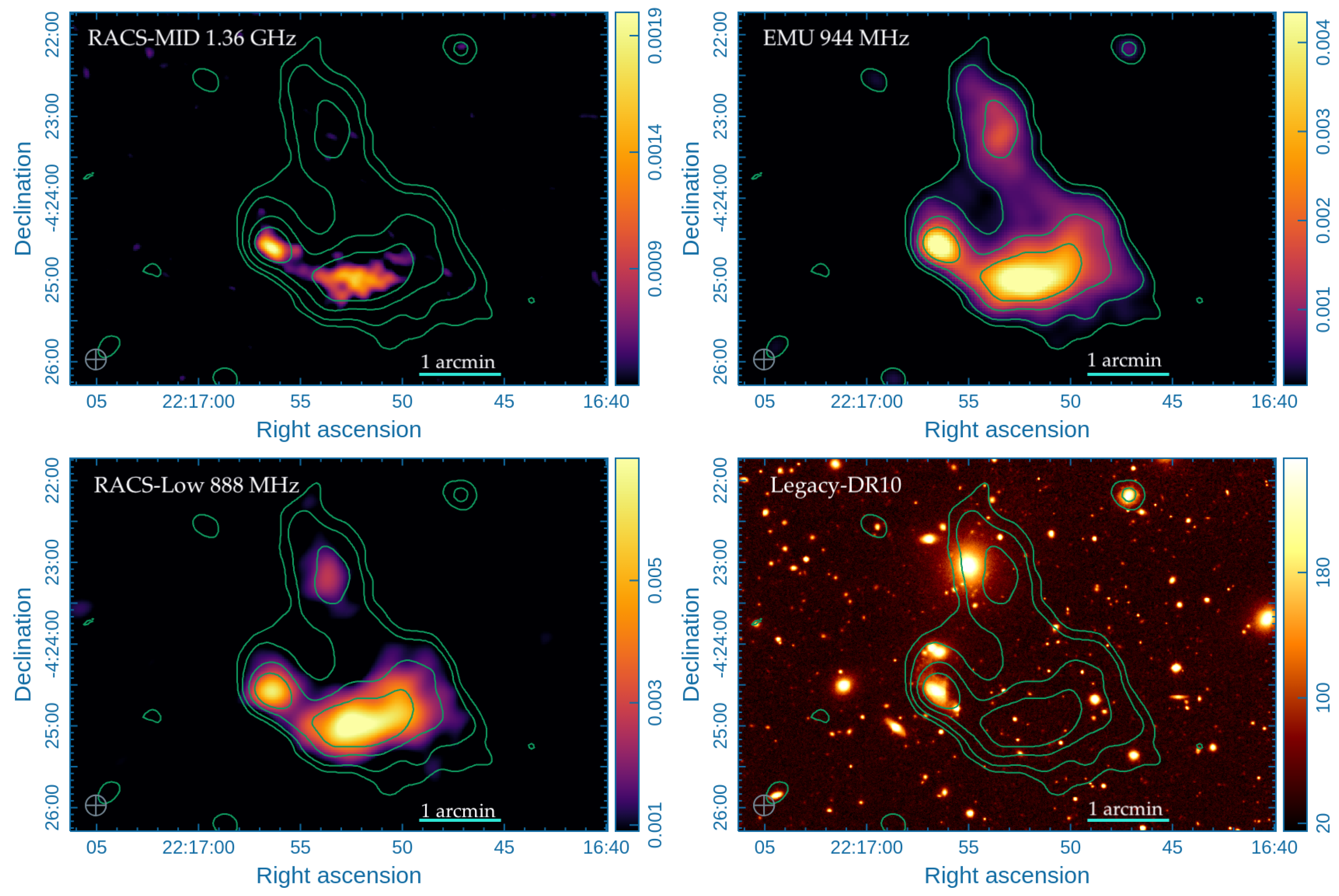


Disclaimer/Publisher’s Note: The statements, opinions and data contained in all publications are solely those of the individual author(s) and contributor(s) and not of MDPI and/or the editor(s). MDPI and/or the editor(s) disclaim responsibility for any injury to people or property resulting from any ideas, methods, instructions or products referred to in the content. |
© 2025 by the authors. Licensee MDPI, Basel, Switzerland. This article is an open access article distributed under the terms and conditions of the Creative Commons Attribution (CC BY) license (https://creativecommons.org/licenses/by/4.0/).
Share and Cite
Apoorva, P.; Hota, A.; Dabhade, P.; Navaneeth, P.K.; Nayak, D.; Purohit, A. RAD@home Citizen Science Discovery of Two Spiral Galaxies Where the 30–220 kpc Radio Lobes Are Possibly Shaped by Ram Pressure Stripping. Galaxies 2025, 13, 98. https://doi.org/10.3390/galaxies13050098
Apoorva P, Hota A, Dabhade P, Navaneeth PK, Nayak D, Purohit A. RAD@home Citizen Science Discovery of Two Spiral Galaxies Where the 30–220 kpc Radio Lobes Are Possibly Shaped by Ram Pressure Stripping. Galaxies. 2025; 13(5):98. https://doi.org/10.3390/galaxies13050098
Chicago/Turabian StyleApoorva, Prakash, Ananda Hota, Pratik Dabhade, P. K. Navaneeth, Dhruv Nayak, and Arundhati Purohit. 2025. "RAD@home Citizen Science Discovery of Two Spiral Galaxies Where the 30–220 kpc Radio Lobes Are Possibly Shaped by Ram Pressure Stripping" Galaxies 13, no. 5: 98. https://doi.org/10.3390/galaxies13050098
APA StyleApoorva, P., Hota, A., Dabhade, P., Navaneeth, P. K., Nayak, D., & Purohit, A. (2025). RAD@home Citizen Science Discovery of Two Spiral Galaxies Where the 30–220 kpc Radio Lobes Are Possibly Shaped by Ram Pressure Stripping. Galaxies, 13(5), 98. https://doi.org/10.3390/galaxies13050098





